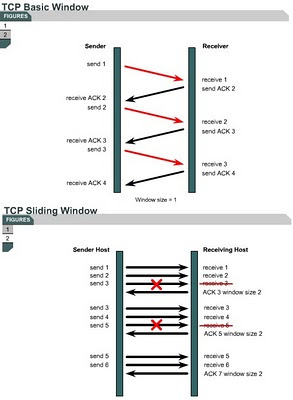Windowing
11.1.5 This page will explain how windows are used to transmit data.
Data packets must be delivered to the recipient in the same order in which they were transmitted to have a reliable, connection-oriented data transfer. The protocol fails if any data packets are lost, damaged, duplicated, or received in a different order. An easy solution is to have a recipient acknowledge the receipt of each packet before the next packet is sent.
If a sender had to wait for an ACK after each packet was sent, throughput would be low. Therefore, most connection-oriented, reliable protocols allow multiple packets to be sent before an ACK is received. The time interval after the sender transmits a data packet and before the sender processes any ACKs is used to transmit more data. The number of data packets the sender can transmit before it receives an ACK is known as the window size, or window.
TCP uses expectational ACKs. This means that the ACK number refers to the next packet that is expected.
Windowing refers to the fact that the window size is negotiated dynamically in the TCP session. Windowing is a flow-control mechanism. Windowing requires the source device to receive an ACK from the destination after a certain amount of data is transmitted. The destination host reports a window size to the source host. This window specifies the number of packets that the destination host is prepared to receive. The first packet is the ACK.
With a window size of three, the source device can send three bytes to the destination. The source device must then wait for an ACK. If the destination receives the three bytes, it sends an acknowledgment to the source device, which can now transmit three more bytes. If the destination does not receive the three bytes, because of overflowing buffers, it does not send an acknowledgment. Because the source does not receive an acknowledgment, it knows that the bytes should be retransmitted, and that the transmission rate should be decreased.
In Figure , the sender sends three packets before it expects an ACK. If the receiver can handle only two packets, the window drops packet three, specifies three as the next packet, and indicates a new window size of two. The sender sends the next two packets, but still specifies a window size of three. This means that the sender will still expect a three-packet ACK from the receiver. The receiver replies with a request for packet five and again specifies a window size of two.
The next page describes the acknowledgment process.
11.1.5 This page will explain how windows are used to transmit data.
Data packets must be delivered to the recipient in the same order in which they were transmitted to have a reliable, connection-oriented data transfer. The protocol fails if any data packets are lost, damaged, duplicated, or received in a different order. An easy solution is to have a recipient acknowledge the receipt of each packet before the next packet is sent.
If a sender had to wait for an ACK after each packet was sent, throughput would be low. Therefore, most connection-oriented, reliable protocols allow multiple packets to be sent before an ACK is received. The time interval after the sender transmits a data packet and before the sender processes any ACKs is used to transmit more data. The number of data packets the sender can transmit before it receives an ACK is known as the window size, or window.
TCP uses expectational ACKs. This means that the ACK number refers to the next packet that is expected.
Windowing refers to the fact that the window size is negotiated dynamically in the TCP session. Windowing is a flow-control mechanism. Windowing requires the source device to receive an ACK from the destination after a certain amount of data is transmitted. The destination host reports a window size to the source host. This window specifies the number of packets that the destination host is prepared to receive. The first packet is the ACK.
With a window size of three, the source device can send three bytes to the destination. The source device must then wait for an ACK. If the destination receives the three bytes, it sends an acknowledgment to the source device, which can now transmit three more bytes. If the destination does not receive the three bytes, because of overflowing buffers, it does not send an acknowledgment. Because the source does not receive an acknowledgment, it knows that the bytes should be retransmitted, and that the transmission rate should be decreased.
In Figure , the sender sends three packets before it expects an ACK. If the receiver can handle only two packets, the window drops packet three, specifies three as the next packet, and indicates a new window size of two. The sender sends the next two packets, but still specifies a window size of three. This means that the sender will still expect a three-packet ACK from the receiver. The receiver replies with a request for packet five and again specifies a window size of two.
The next page describes the acknowledgment process.

Comments
Post a Comment